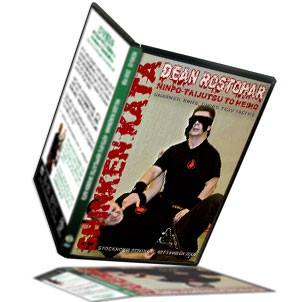Takagi Yoshin-ryu Curriculum
From Classical Martial Arts Research Academy by Kacem Zoughari
Each time I do a Takagi Yōshin-ryū seminar I show this. I hope it gives you an idea of how deep the art is, and everything you need to sacrifice if you want to learn something; the price is always heavier than the sacrifice itself.
This is only one densho, there are three like this and four makimono, and I have only one. The others I have only seen, I don’t have the level yet.
This is Takagi Yōshin-ryū densho (高木陽心流傳書), and there is Takamatsu’s Uncle’s signature.

Here is Takagi Yōshin-ryū Shiron (史論), this is the modern history of the tradition. What happened just a little bit before Takamatsu Sensei, maybe one or two generations before. Here you can see: Takamatsu sensei, one, two, and three generations.[1]

After you have the Yobun (前文), a sort of introduction as to what level you should reach before starting this school.
Here we have Takagi Yōshin-ryū Shinden (高木陽心流心傳), it’s the level of transmission of the heart, the kind of mind you need to have when practicing. In another scroll they have this in more important (detail?).
There’s Takagi Yōshin-ryū Jūtaijutsu first level, what we’re going to practice: Shoden (初傳). After, there is Ura Gata (裏型), more complicated techniques.

After there is Shime waza, a way of choking. It’s not like in Jūdō, it’s very different. And then there’s Chūden Gata (中傳型), a middle level. After there’s the part called Tai no Kata (體之型), which is more difficult to read, I think it’s on purpose.
At the end of each section there’s an explanation of the technical level you need to reach technically and spiritually. And it’s always signed by one of the different generations of the school. Each generation brings something more.
Now it’s Mutō Dori (無刀捕之型), this is when you face someone with no weapon [of your own] and they attack you with a sword, or spear. This is the highest level in martial arts, because you need to understand the use of weapons, if you don’t this is impossible to do. And again, at the end of the section you have the sōke, the writing, and the date.
After this theirs is another section called Daisho Sabaki (大小捌), this is with two swords, a small one and a long one. Sometimes you have the two and don’t use them, or you use the two, sometimes just the one. These [techniques] are very complicated.
And all the enemy you fight is a skilled warrior, which means he already killed people, he knows how to fight. It’s not a friend, or a sportsman, it’s someone who’s been on the battlefield, killed, raped, doesn’t care, children, everyone. A specialist of fighting. Or rather, of war, fighting and war is not the same thing; it’s very different. Fighting, you get hurt, you go to sleep, tomorrow, you’ll see [intelligible dialogue overshadowed by translator], it’s alright, tomorrow it’s better. War, you lose you lose.
This is Okuden (奥傳之型), the highest level. And this is divided into two sections: Shirabe Gata (調型) and Moguri Gata (潜型). Shirabe is very difficult because it is when someone wants to do a technique, and he stop you, you must stop him again. So, it’s how to read someone’s movement. This means psychology, sociology, environment, feeling, a lot of things.
And from here we go into the art of Iai (居合), how to draw. And then Torinawajutsu (捕縄術), how to use the rope, and jutte (十手).

And here it’s talking about Kasatsu Jizai (活殺自在), this is how to put someone down, how to break, tear away, tie everything with Hajutsu no hō (破術之法), which is for example all the finger grabs, similar thing. At the same time, it’s also how to heal, which means if you know how to kill you know how to heal. The history of medicine and many cool things start’s like that. You have some mistakes first.
So, this is just the first part of the scroll, and I’m going to read to you the last page, I keep [it separate] because I don’t want to lose it.
“What we just presented is called mokuroku (目録)”, which means a kind of technical index, which doesn’t look like it when I show that here is history, physiology, etc., it’s more than that. “After you master this, there is Chūgokui (中極意), Gokui (極意), and when you have this, you receive Menkyō Kaiden (免許皆傳). This is the four degrees of practice.”
“The mokuroku is made of thirty techniques of omote, and thirty-nine techniques of Ura that you have to practice deeply. You need to learn all this in one year. The level of Chūgokui must be learned in one-and-a-half years. The level of Gokui is learned in five months. Finally, when you do this, you receive mankyo kaiden.”
Generally speaking, after doing all this, this would be like
the level of nidan. When I read this,
it makes me understand the reality. Some people say that the Bujinkan is full
of crazy people, like everywhere, people think they are good, it’s really
complicated.
[1] In another seminar, Kacem explained, “At the end of this history section, there is the genealogy, and here it shows Yanagi, and his three students: Fujita, Ishitani, and Ishitake. And they had three students, Mizuta, Ishita, and Ishitake. And here Takamatsu sensei.”…















